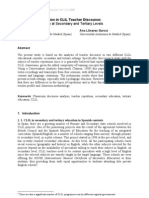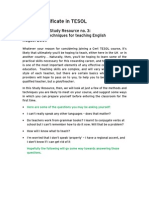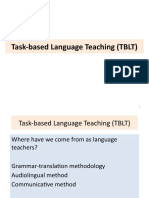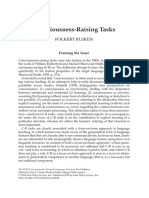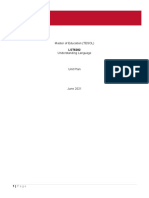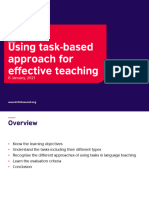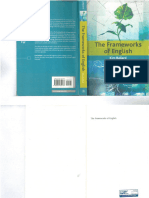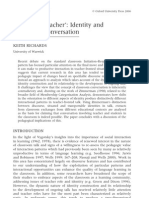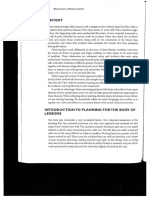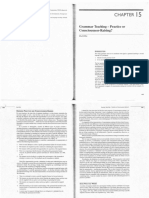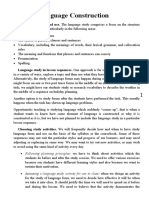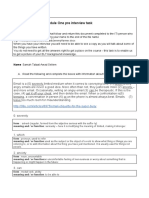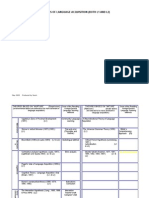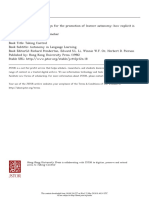100%(1)100% found this document useful (1 vote)
762 views104 pagesTechniques and Principles Language Teaching
The document is a second edition of Diane Larsen-Freeman's work on language teaching methods, which emphasizes the importance of understanding various methodologies in teacher education. It discusses how knowledge of different teaching methods can enhance teachers' professional growth and effectiveness, while also addressing critiques of method-based approaches. The updated edition includes revisions and expansions on previous content, reflecting new developments in language teaching practices.
Uploaded by
Martin BackinthethirdworldCopyright
© © All Rights Reserved
We take content rights seriously. If you suspect this is your content, claim it here.
Available Formats
Download as PDF or read online on Scribd
100%(1)100% found this document useful (1 vote)
762 views104 pagesTechniques and Principles Language Teaching
The document is a second edition of Diane Larsen-Freeman's work on language teaching methods, which emphasizes the importance of understanding various methodologies in teacher education. It discusses how knowledge of different teaching methods can enhance teachers' professional growth and effectiveness, while also addressing critiques of method-based approaches. The updated edition includes revisions and expansions on previous content, reflecting new developments in language teaching practices.
Uploaded by
Martin BackinthethirdworldCopyright
© © All Rights Reserved
We take content rights seriously. If you suspect this is your content, claim it here.
Available Formats
Download as PDF or read online on Scribd
You are on page 1/ 104
Techniques
and Principles
in Language
Teaching
DIANE LARSEN-FREEMAN
Second Edition
OXFORD
eee
Soe oes carne
‘Nest Soule Sgha Tope Taye Toe
Sedition eros
Tenor hore ben
ashe Ue Por
Nemucied eng
sot tm in el no es
Sere oee cu.
SEES A RekeBpcmee Sued tcc
Yop a ny eng ee
Ieijoraenpsaem nde acres
SASS GO OMLATN ee daca soe
Series Editors’ Preface
Iisaays a fing of get pride for general editors of a pdagonia
seves wea the resounding succes of one of ts books Teds to te
‘nad for publction of second, expanded ein. Weare therefore
‘remly pleased that Diane LaseaFremap has undeaen 1 eon
tute nthe fldoflngungeeaching profesional new tered,
‘ised, and colarged version of her gel sad ences aoa
“elmiques and Ponies in Language Teaching The ways i which the
‘cond eft difers fom te feet the aidan of aw methods,
through more aention fo he eaming poses oa eel lgree
Inimethodologeal ehoie—are amply documerte ig Dane's own nes
‘age To the Teacher Favestor’ and thee are departures ha ate both
‘propriate apd iluminaing, What bas not changed, however—20d
Ios woul prevent her fom saying sore the incangible qualities
‘Getmade te fc eliton wo special: enighenment without conde
Son, comprehemsvenr without ou, eogagemen with eves
‘acon Sil evident au before Danco being ble atl 0
fend one to examine one's own profesional havior for posite incon
‘Stes between on view of lnguspe andthe way one teaches it And
‘cles even eid, evden ber seo a epy postal
though devoted to complex pedapopal issues and he incomparable
“ily to make thse mates come sive wih great clay forthe Widest
olloaareadersip tis wo meen scomplchment
RassllN, Camptell
‘ili Rutherford
‘Tomy parents, Elaine and Randolph Larsen,
with heartfelt gratitude for thei love and
encouragement
Contents
Acroledgments
othe Teacher Educator
Iecodction|
‘The Grammar Tranlton Method
TheDirece Method
“The Audio-Lingual Method
‘The Silene Way
Desugustopetin
Commanity Language Learing
“Total Physical Response
(Conese, Task based, and Paricpatony
Aoqonches
Learning Strategy Tsing, Cooperative Lering,
and Mafeplelneligence
Colin
Appendic
07
159
Acknowledgments
nwa bein by thankingthe readers ofthe ist dition ofthis book. Your
‘ceive hs enabled me ro publh thir opted second eon a
‘Sion, char been oy tosnterac wih you.
"The appcath | have dein hit Book is baked on my experince in
{sichng the methodlsppreaches couse at he Schoo! or Ineraton
“Taining This book would not have ben wren i he Brat lace it
‘wernt fo the infec of colleagues hee Tam very
{atl ohem al pricy forth cond eition, Imus singlet
Ectslyn Nin who went out of her way to give me cocmment besed
‘spon her experienc in using the Book in teacher education program
Debra lke and Bil Coney were sho bind enough wo eead porns of
‘hiemanasenpe and offer comments.
“Thr book helo bene rom he fact ha ending nethodoogits
save eneounlyespondd toy eoquet fo feedback on portion of
tmanuserpe Iam indebid to Hal Stevi [To the Teacher Educator),
Shake: Gategso of Edacational Solutions Inc (Sent Way), Gears
‘rao Alison Mile an Tetso Nisha (Dessggstopedi), Jenny
tele Ravin and Pat Tisneof Counseling Lerng Inte (Comme
sy Langucge Lesning) James Aer (Tova Phys Reon),
Maroc Wexce (contented nation), and Els Averbach pare.
Ipatryappeech). Ther comments made me fee mor conBeat ha
Hv interpreted the methodol’ intent Iam alo gatfl forthe
‘amments of Ruth Wary of LARA Consultancy in Australi, and
Joann Crandall: Any semaiig errs of nerpetation are, of eure,
fey eyesponiby.
For the fil faith they showed and fr thei continued encourage
ment and blpal suggestions, acknowledge with ratadethe eto of
‘hisses, Resell Campbell and Willa Ruerford.
Tt haw ais been lease working with he dtr at Oxford Univer.
sip Pre Sst Ange Conybeare aad thes Jb Saab
"analy Lut express my deep appreiation tomy spose, Eliot, who
has at always, pen mci support hrughou his Poet
Diane Larsen Freeman
To the Teacher Educator
OW LANGUAGE TEACHING METHODS AND THEIR USE
IN TEACHER EDUCATION
Asad of methods isinvaluale in teacher education nat les ive way
1 Mods sere a fol fr refeton that an ad racers in ringing
‘o concious awareness the thinking that under thar actions, We
Know that teachers come vo tescher tinng with ideas aot the
‘eachigetning process formed om the yersthey hae spent a st
dens themselves (Loe 1975) A major parpone ofeach education
ie to elp racers make che ac exp (Shultn 1987, Freeman
1991) When teachers are expored to thode and ake wo eft on
‘ei prnciles and acivly engage with thir techniqes, they cat
come eter bout why they do what they do They become seare
‘oftheir own fandarenal asumpsion values and bel:
2 By becoming clear on whexe hey stand testers can choose teach
Airey fom the way they ware tanh They ace sl tse hy
they are atracted to etal metho at red yaar Ty ae
blo make choices that ate informed, nt conditioned Tey may be
‘he cess, or atest argue aa, the snpostion ofa particular
‘cod by authors. In ecerstaations, where method hot
‘imposed, tethods offer echersaleratvs to whot they carrey
think and do. des act neesy flow that teaches wlchooe to
‘of ther caren pace. The point i that hey will ave the
tndestanding to ds, fthey are acto nd wan to,
3 Aknowlge of methods x part of the knowlege bse of eaching
‘Withigeachersjoina community of practic Freeman 192), Belagt
emmy meer nals rninghe pefeonal aco that co
‘many merber us so that peofesonal dog ean ake place Bing
tof couse community confers profesional esi and co
ect eachers with oles 0 they ar not so ulated inthe race
4A profesional cous community maya challenge teacher on
‘tons of how teaching leads to lerning Interacting with thes
x Tothe Teacher Edcator
conceptions of practic pep acer teaching aive—belp pe
‘ent irom bosming ele and one routine (Prabho 199),
5 Alaowledge of methods helps expand a teacher’ repertoire of tech.
‘igus Thi inal provides a 2tinal ave for profesional
{rowt, as some teicher find thei way t0 new phloopha pos
‘Son, ot by fst etertsning new principe, bt rater y tying out
‘ew tecnsqes. Moroney efesie teachers who ae mote expt
nced and expert have a lrge, diverse seperore of but proties
(Arends 199), which presumably helps them dea mote effectively
‘che unig quater and oye of tee ste
Despite these peel gins fom a sud of methods it isinportane to
schnowiedge tht sinc he ableton ofthe ft edison ofr ook in
1986,» amber of writers nour ld have eid the concepe olan
tage teaching methods. Some say that methods ae prescriptions for
lasroom behav and that teachers re encouraged by texthouk pub
lakers and academics to implement hem wheter or no he methods ae
appropiate fora partular context (Penayeoak 1989; Rickard 190;
Holiday 194). Others have ord tht the earch fore bese method
ihadvised (Prabha 190; Beraome 199), ha wachers do ot thik
bout methods when planning thie leone (Long 1991), and that
‘methodological late us ie aboot what relly ecarsinclaoons
(Allwrighe 1985; Kae 1996),
“These cris have made me stop and think. suppose ire,
‘housht dat parla method canbe impo on teacher by other.
owes ths ther ae Hel tobe disappointed they hope that man
ating sparseslr metho wil led to andardastog, or We kw
that eching more han flowing 2 ecipe. Any methods ong to be
Shapedby a teacher own underandig, li spe and level of expe
"enc. Teaches are not mere conveyor le deneringlnguap oagh
Intent prescribed snd proscribed hehavios (arterecan 1991),
they ae professionals who can in the et of ll worl, make hei own
dein. They ae informed by ther wn expeienc, the Badings rom
‘evar, and the wisdom of pace secumalated by he profession ey
focexampl,Kurmarvadivela 1994).
arthermor, a method dacontextualzd. How a method is imple-
meted inthe casroom i oing to te affected not only by wh the
teacher ba alo by who te sadent aera the eacher exper
tations of appropriate soil tok, the istittonal constants tad
‘mands, and factors connected to he wie sococasral context
hich he istration aes place en the sgh? method will no com
‘Tothe Teacher Educator xi
pent frinadeguate conditions of etznng ox overcome scipolicl
neque. naddion, decisions that teachers make are oenafeced by
‘cogent the asroom rather than by methodologies conidee
Sons Sayegh precular method ix praia certainly doe not ie
Sethe whole pacar of wha i happening in the claseoor. Then, to,
tine «method is moe strat thas tening activ, aot supe
Sng tht teacher think in rerms of atvites ether than methodol
shies when they plan th sons,
“Thaw undersea the cet 1 not believe tha td of
language teaching methods should be exe! from langage teacher
sdacvon Iti not methods, but how they ae wed ha te. A
Study of methods nnd not ed othe desing of teachers tater
Eanserve a variety of stl funeions when sed peopl teacher
duction Iecam lp eachers atc and peshap ransorm, thet
Understanding of the teachingleaning prose, Methods can seve at
‘odes of he lngraton of theory (he rnp) and practice he tech
niques). The study can enoarape continsing education te llong
proces of learning to teach (Larsen Freeman 1998), Teachers and
feacer cate shuld to be Minded by he ertcme of methods and
thos fal to se the invalanble contbution ro teicher eduction and
Continuing devlopment. Key to doings hough storing beyond
tology to inquiry, 8 movement to which I hope this back wil oo
tabu
‘CHANGES IN THE SECOND EDITION
In adition to some modes updating fal he methods peste inthe
fisteition, Chapter 6has undergone a subsanal reviton rele the
«volun of Sugesopedia rat edition) to Desggeopedi inh
tion, Forte the nection (Chapter 1} has ben expended. Contrary
to thase who fear hat «method il be imposed om pationer, my
‘experince asa teaceredvstor tht the challenge ht In geting tac
‘rc eave behind teaching as they were taught and become awa of,
ind pen aerate. therefore welcome te opportnty tha he
“expanded cape ha gen met elaborate om one way tha openness
‘ante encouraged
“Another ange the inchson of methods thathave come into promi
ence sine the at etn ofthis book. In err to kee ths bok rms
Iecomingto long, [nave grouped a number of metods int capers.
In addon to considerations of length, Ihave justified this decision
Ircause seems these method have in common the vow tit Sst
Mi Tote Teacher Educator
language can bese be red when i taughe through communition,
rather for Caper 0, on conte sey and por
tory approach), and second, Ut Lngsage cqestion an be
Enhanced by working oot only on langage bt shoo te pros of
teaming (Cher 11s ering sexes, cooper ing nd
‘lle lige)
“farther usta modifcation that the epiloge ofthe ft
sion as grown mo a fal ehaper of ts own (Cpe 12) seo
Scicon Readers of he rt ton have tl eta they whe ee
ind concaded with more explicit evaluation and comparizon of the
smtiodsIchoe not wo do vo inthe Bt eon of his both a am not
{he option ta the arp of ering sbow metho 0 one ca
dot the igh ne tat I cou chose for ehers which on ht
‘wot be. However i th seond eft, have responded to readers
‘ucts by providing «summary chart ofthe methods sca nis
bool and bys dong ighihng thr jor dfleences ave aloo
sede opportuni thal al hater presents onde myst
sharing with readers my views on making informed meddle
Soles.
‘A word about nomenlatre i aso in ord mong the tem
‘acho here norco mean formula prescription, bathe nearer
‘tof links between principles and ceaintceiges snd procedure
Anthony (1863) hs made the cane for rpariteheschy. Ase pot
« ecigns ary outa med which consent wan apron
(0-64), Flowing Anthonys cain ofthe chaps wil ode
stiular method by shone hows a exaieof4mare omea
"pproach to lnpuage teaching However, not aller dace
ths book conveinly follow ftom a geneal approach They all do
though, have both a coaepa od a operational componc, ng
‘he dion in Richards ef a 1982) Dctonay of Language Teng
© Apple Lng (rho e's wry of ecg guage Wh
Jn bated om systema pines and prcedte at pstfng yee
the tim.Admiely.someines ave fod dictate em
method wit mote een iovatins, Sach ax const ated inte
stn and cooperate lesning. At tims, | have rsd Yo the em
‘netodologial innovations
reno, some lnguaeedocator might obj tothe inion fon-
‘encased tsk ased nd partiptoyappeoaches ina mths bok
for hey might be mae comfortable cling hse labs pee Neve
‘thea ther feel hata metho designation ey sppepeate ew
(1591) forisanes, characte conn atdnauctonassetiod
‘Tothe Teacher ductor xi
with nny faces boho make she case fr cote sd inaction asa
‘method of language teaching, andro pte gen arty of fos
Sndsengsin which takes place: Kermaraadiea 1993) obucre that
thetern asst used with ference tobethconten end method
ogy oflnguape teaching Indeed, within he rong eson of comm
meative approach (Howat 1988) he radon separation of labs
You might also like
- Cook Using The First Language in The Classroom 1 PDF100% (1)Cook Using The First Language in The Classroom 1 PDF22 pages
- 1 - Brown - Lee (2015) Selected Pages Chapter 8No ratings yet1 - Brown - Lee (2015) Selected Pages Chapter 85 pages
- English For Specific Purposes (Case Studies in TESOL Practice Series)100% (1)English For Specific Purposes (Case Studies in TESOL Practice Series)240 pages
- The Role of Repetition in CLIL Teacher DiscoursceNo ratings yetThe Role of Repetition in CLIL Teacher Discoursce10 pages
- Dictating or Facilitating: The Supervisory Process For Language TeachersNo ratings yetDictating or Facilitating: The Supervisory Process For Language Teachers16 pages
- (ELT Journal 1991-Jul Vol. 45 Iss. 3) Thornbury, S. - Metaphors We Work by - EFL and Its Metaphors (1991) (10.1093 - Elt - 45.3.193) - Libgen - LiNo ratings yet(ELT Journal 1991-Jul Vol. 45 Iss. 3) Thornbury, S. - Metaphors We Work by - EFL and Its Metaphors (1991) (10.1093 - Elt - 45.3.193) - Libgen - Li8 pages
- Thematic Unit For Esl Listening and Speaking Course100% (1)Thematic Unit For Esl Listening and Speaking Course26 pages
- CLIL Wheel 4Cs & 10 Parameters CombinedNo ratings yetCLIL Wheel 4Cs & 10 Parameters Combined12 pages
- Methods and Techniques For Teaching English CertTESOLNo ratings yetMethods and Techniques For Teaching English CertTESOL7 pages
- Content and Language Integrated Learning - TeachingEnglish - British Council - BBCNo ratings yetContent and Language Integrated Learning - TeachingEnglish - British Council - BBC5 pages
- Diplomatic English: Polite Workplace Communication100% (1)Diplomatic English: Polite Workplace Communication7 pages
- The Frameworks of English - Kim BallerdNo ratings yetThe Frameworks of English - Kim Ballerd159 pages
- Luiz Otavio Barros: Teaching Spoken English at Advanced Level100% (1)Luiz Otavio Barros: Teaching Spoken English at Advanced Level22 pages
- Cheng and Fox (2017) - Beliefs About AssessmentNo ratings yetCheng and Fox (2017) - Beliefs About Assessment13 pages
- Dogme ELT Techniques for Textbook ClassesNo ratings yetDogme ELT Techniques for Textbook Classes8 pages
- Theories of Language Acquisition (Table ( (R)100% (2)Theories of Language Acquisition (Table ( (R)14 pages
- 2.4 Teaching Large Multilevel Classes - Nathalie Hess PDF100% (1)2.4 Teaching Large Multilevel Classes - Nathalie Hess PDF15 pages
- Current Perspectives On Teaching The Four SkillsNo ratings yetCurrent Perspectives On Teaching The Four Skills24 pages
- Northstar Listening Speaking U8 Endangered Languages With Ak 1 - Rotated CompressedNo ratings yetNorthstar Listening Speaking U8 Endangered Languages With Ak 1 - Rotated Compressed15 pages
- Prabhu (1990) - There Is No Best Method - Why PDF100% (1)Prabhu (1990) - There Is No Best Method - Why PDF9 pages
- Approaches and Methods in Language Teaching - Chapter 20No ratings yetApproaches and Methods in Language Teaching - Chapter 2017 pages
- Book 3 Capetown - Vaughan Groups Guide 2023-24No ratings yetBook 3 Capetown - Vaughan Groups Guide 2023-24105 pages
- Book 2 Canberra - Vaughan Groups Guide 2023-24No ratings yetBook 2 Canberra - Vaughan Groups Guide 2023-2498 pages
- Book 1 Wellington - Vaughan Groups Guide 2023-24No ratings yetBook 1 Wellington - Vaughan Groups Guide 2023-24107 pages









